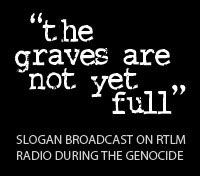Encounters with conflict and peace
Hate radio
Anti-Tutsi articles and graphic cartoons began appearing in the Kangura newspaper from around 1990.
In June 1993 a new radio station called Radio-Television Libre des Mille Collines (RTLMC) began broadcasting in Rwanda…
The station was rowdy and used street language - there were disc jockeys, pop music and phone-ins. Sometimes the announcers were drunk. It was designed to appeal to the unemployed, the delinquents and the gangs of thugs in the militia. “In a largely illiterate population, the radio station soon had a very large audience who found it immensely entertaining.” (Linda Melvern)

The U.S. - "We believe in freedom of speech"
Its stated aim was “to create harmonious development in Rwandese society” but nothing could have been further from the truth. It was set up and financed by Hutu extremists to prepare the people of Rwanda for genocide by demonising the Tutsi and encouraging hate and violence.
Some people - including the Belgian ambassador and staff of several aid agencies - recognised the danger and asked for international help in shutting down the broadcasts, but it was impossible to persuade western diplomats to take it seriously. They dismissed the station as a joke.
David Rawson, the US ambassador, said that its euphemisms were open to interpretation. The US, he said, believed in freedom of speech.
Some people - including the Belgian ambassador and staff of several aid agencies - recognised the danger and asked for international help in shutting down the broadcasts, but it was impossible to persuade western diplomats to take it seriously. They dismissed the station as a joke.
David Rawson, the US ambassador, said that its euphemisms were open to interpretation. The US, he said, believed in freedom of speech.
TALKING IN CODE...
The radio told people to go to work and everyone knew that meant get your machete and kill Tutsis.
Many Rwandans, however, knew the threat. ‘I listened to RTLMC’, said a survivor, ‘because if you were mentioned over the airways, you were sure to be carted off a short time later by the interahamwe. You knew you had to change your address at once.”
based on information in A People Betrayed by Linda Melvern
Who was behind the radio station?

< previous page | next page >
In this section
STARTING A GENOCIDE
Whose idea was it?
How did it start?
The foreigners are leaving
Hate radio
DETAILS
Roadblocks
The little things
INSIGHT
A simple plan
This new job
A strangeness of mind
Personalities
A good man
FOCUS ON THE BUGESERA
The Bugesera
Ntarama church massacre
A day in the marshes
MZUNGUS
The role of the west
Two French missionaries
A journalist's story
THE END OF THE GENOCIDE
The refugee crisis
A country with nobody home

Whose idea was it?
How did it start?
The foreigners are leaving
Hate radio
DETAILS
Roadblocks
The little things
INSIGHT
A simple plan
This new job
A strangeness of mind
Personalities
A good man
FOCUS ON THE BUGESERA
The Bugesera
Ntarama church massacre
A day in the marshes
MZUNGUS
The role of the west
Two French missionaries
A journalist's story
THE END OF THE GENOCIDE
The refugee crisis
A country with nobody home

